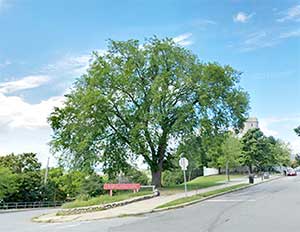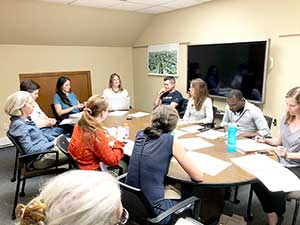
The majestic American elm grows to 80-100 feet high with leaves 3-5 inches long. The Prospect Hill American elm is probably more than 100 years old and is 40″ in diameter. — Photo courtesy of Google Maps
By Denise Keniston
One of Somerville’s largest and oldest trees may have Dutch elm disease. Dutch elm disease is a ruthless beetle–fungus alliance that all but wiped out the beloved American elm nationwide over the past several decades.
The Prospect Hill American elm, located on the corner of Munroe Street and Prospect Hill Parkway, was wrongly cataloged as a disease-resistant Siberian elm by the city for years and thus overlooked. Once reclassified, the city started trying to save the legacy tree. Samples gathered last year came back negative for Dutch elm, but the unrelenting disease is aggressive and hard to detect.
“We still think it might have Dutch elm disease, it’s possible we just didn’t find it in that particular sample,” said Vanessa Boukili, Somerville’s Urban Forestry and Landscape Planner. “We did go ahead last year with a one-time injection for fast-acting treatment with the intention this year of treating with a longer-term fungicide.”

This summer’s hot, wet conditions may have further compromised the tree. The taskforce, reporting to the Urban Forestry Committee, will research possible treatment options by reaching out to the Boston Arboretum and other experts for advice. — Photo by Denise Keniston
The tree was the first order of business at the Somerville’s Urban Forestry Committee meeting Thursday, July 18 at City Hall. Members learned the tree shows further signs of dieback and stress this summer.
“Let’s discuss the fertilization issue sooner than later,” said Committee Member and scientist Jennifer Clifford. “I think that by promoting some health for the tree – because we don’t know what the issue is with it right now, what the cause of the dieback is – fertilization can ‘sure up’ the health of the tree, which can be one of its best defenses and then tackle with treatment after that.”
The Prospect Hill American elm taskforce was formed and will research options and report back to the Committee at large. Taskforce Citizen Member Mandy DeBurro has a deep connection with the tree. “I can’t even put into words how spectacular this tree is,” said DeBurro. “In my heart, I want to make sure we’re doing everything we can to save this magnificent tree. I want to turn over every rock, leaf, and stone to save it!”
The outlook can be bleak. Several years ago the legendary Olmstead elm was taken down in Brookline. Dutch elm disease had slowly eaten at the tree from the inside for several years. That, coupled with another fungus, spelled the end of the venerable tree.
There is hope for the future. Boukili has planted twenty new elm trees over the past couple of years that are Dutch elm disease resistant. In all, there are one hundred and thirty-one elms in Somerville. “There’s no replacing the historical significance of the Prospect Hill elm tree,” said Boukili. “It’s probably more than one hundred years old, and it provides a lot of environmental benefits and has a lot of character.”
Saving an American elm can be costly. The Urban Forestry Committee has access to a $15k fund, but it’s unclear whether efforts to save the Prospect Hill elm will fit the guidelines. “It just seems to me that saving one of Somerville’s biggest trees, on the tallest hill is worth the effort,” said Committee Member (co-chair) Chris Dwan. “The task force will help us move more quickly to find out what’s wrong with tree and access funds if we have to.”
The City of Somerville provides a thorough tree inventory online with detailed statistics and environmental benefits of more than 25,000 trees. You can access it with this link or going to www.somevillema.gov and searching “tree inventory”: https://www.somervillema.gov/departments/office-strategic-planning-and-community-development-ospcd/ospcd-urban-forestry.












For the first time in a long time I believe in this committee. Compared to all the rest of them in Somerville. I am not a tree hugger, but I like and enjoy the look of city trees. They bring shade, and help our environment in many ways. When I was younger Somerville had a good amount of American chestnut trees that were destroyed by disease. So anything they can do to protect, plant, cultivate, etc, I am in support of. I’d like to remind my fellow citizens, if you have a recently planted tree or one that’s in its early growing stage, in the heat of the summer give it a 5 gallon water bucket once a week.